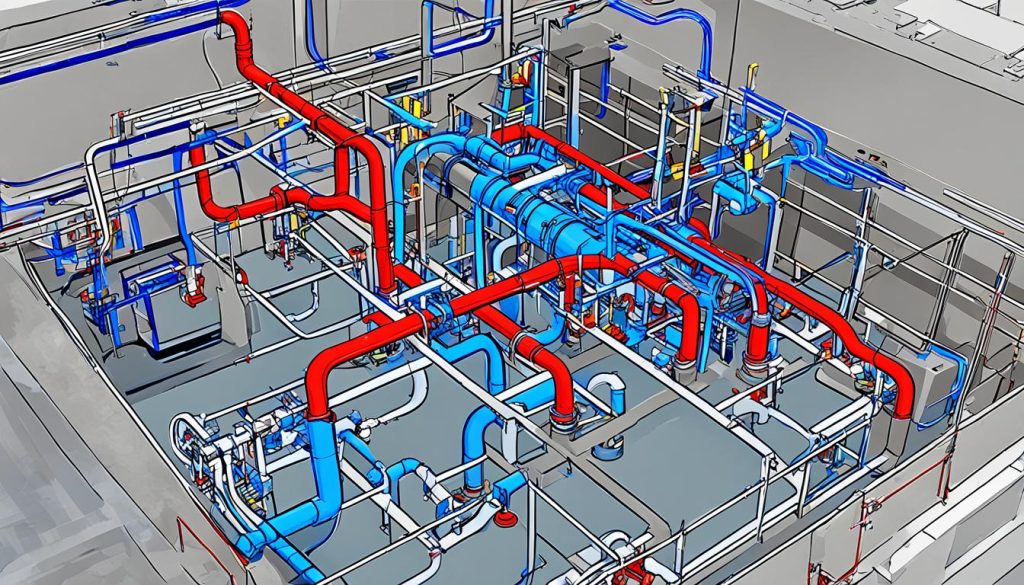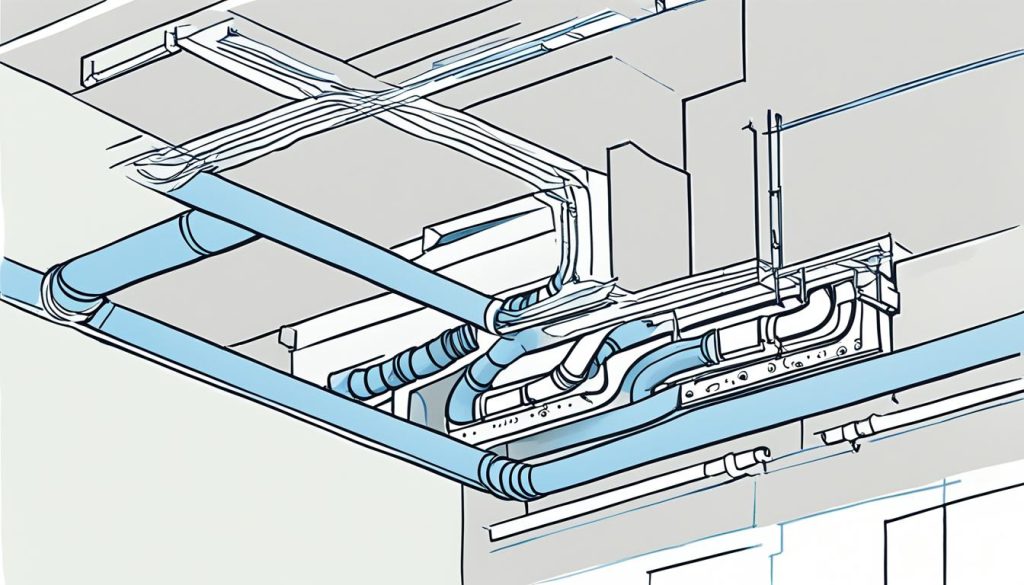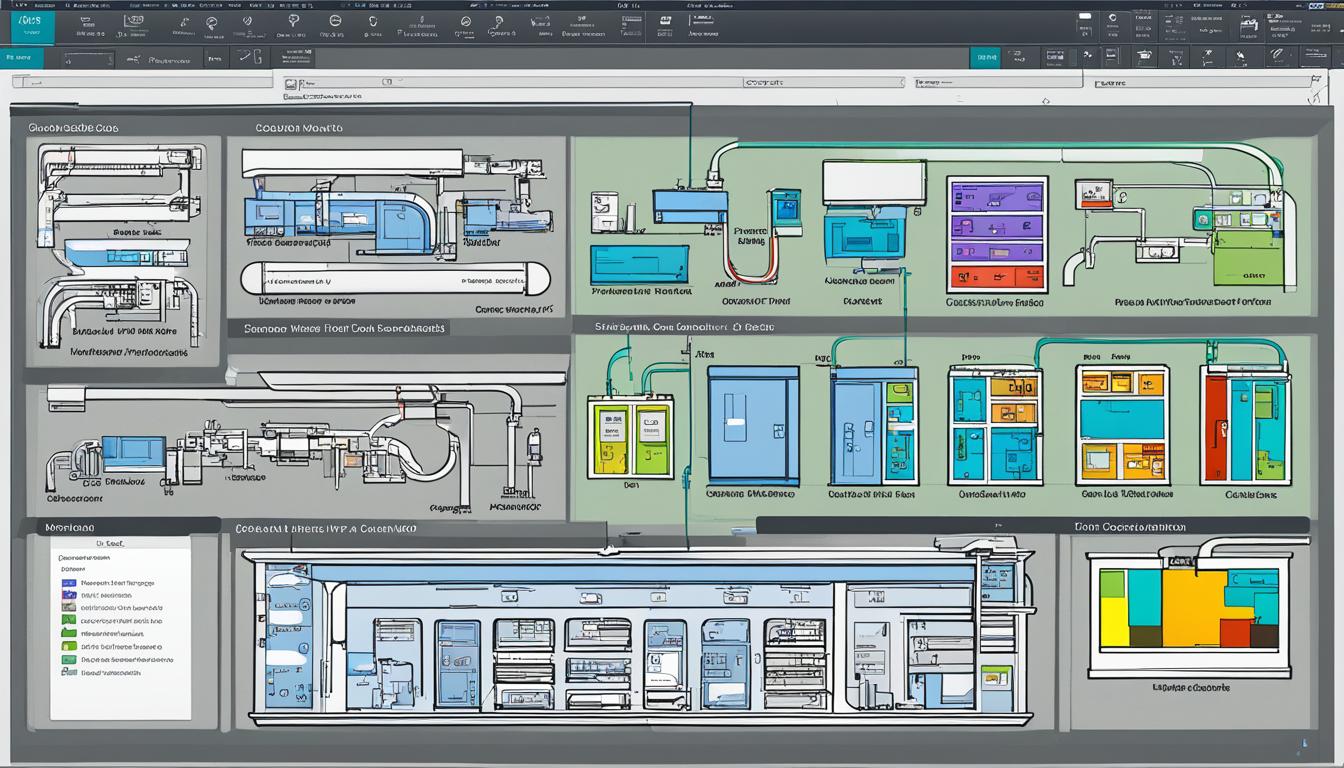You can make ductwork more efficient with AutoCAD HVAC software. It has powerful tools for making 2D and 3D models of HVAC systems. This tool lets you draw detailed layouts, components, and ductwork. It also does important calculations and simulations.
AutoCAD HVAC software tutorials guide you on how to make ductwork better. They show you how to follow best practices for HVAC duct design. By learning this software, you can check how well systems work. This includes airflow, pressure, temperature, and energy use. This ensures your designs are very efficient.
The software has a user-friendly interface, lots of symbols, and options to customize. As you learn more about it, you’ll see how to make duct designs that save energy. These designs improve airflow and reduce pressure loss. This leads to HVAC systems that are better for the planet and save money.
Understanding AutoCAD HVAC Software Basics
AutoCAD HVAC software changes how you design ductwork. It blends precision with efficiency, making it vital for HVAC pros. Let’s explore the main parts of this software and how it can make your work easier.
Key Features of AutoCAD for HVAC Design
AutoCAD HVAC software has many features for your design needs. You’ll find tools for creating layers to keep your drawings tidy. Layers help separate different parts like ductwork, electrical, and plumbing. The software also includes blocks and dynamic blocks for easily making and using design elements.
Interface Overview and Navigation
The interface of AutoCAD HVAC software is easy to use. It has a ribbon-style menu at the top for quick tool access. The drawing area is in the middle for creating your HVAC designs. On the left, the Properties palette lets you change object attributes fast.
Setting Up Your HVAC Project in AutoCAD
To begin your project, think about HVAC ductwork design first. Start by setting up your drawing units and scale. Then, make layers for your HVAC system’s parts. You can import or create a floor plan as a base for your ductwork design. With these steps done, you’re set to draft your HVAC system well.
- Set drawing units and scale
- Create layers for HVAC components
- Import or create a floor plan
- Begin drafting your HVAC system
Duct and Diffuser Layout Fundamentals
Learning how to calculate HVAC ductwork is key for efficient system design. AutoCAD HVAC makes this easy by letting you create detailed layouts and manage airflow well. Let’s look at the main parts of duct and diffuser layout in AutoCAD.
Drawing Double-Line and Single-Line Ductwork
AutoCAD HVAC lets you show ductwork in two ways. Double-line gives a detailed look at duct sizes, while single-line is better for overall layouts. You can switch between these styles as needed, making sure your ducts are the right size and using the right materials.
Connecting Diffusers to Ductwork
Adding diffusers to ductwork in AutoCAD HVAC is easy. You can put diffusers in place and link them to the main ducts. The software also figures out the airflow needs, making sure air is spread out evenly in the system.
Generating Diffuser Schedules within AutoCAD
AutoCAD HVAC makes making diffuser schedules easy. As you design, it keeps track of all parts and updates schedules automatically. This keeps things accurate and saves time, letting you focus on making your HVAC system work better.
| Feature | Benefit |
|---|---|
| Double-line drawing | Detailed duct dimensioning |
| Single-line drawing | Quick schematic layouts |
| Automatic diffuser connection | Balanced airflow distribution |
| Real-time schedule updates | Increased accuracy and time savings |
By getting good at these basic layout skills in AutoCAD HVAC, you’ll be ready to design ductwork systems that work well. They’ll make sure airflow is efficient and energy use is low.
CFM and Sizing Calculations in AutoCAD HVAC
AutoCAD HVAC software makes CFM and sizing calculations easy. You can set CFM needs for each diffuser in your HVAC system with this tool. It also keeps duct shapes correct during sizing, saving you time and effort.
Using AutoCAD HVAC for ductwork design has a big plus. You can size the whole system with just one command. This lets you make duct changes based on specific needs, ensuring the best airflow in the building.
AutoCAD HVAC calculates airflow based on the building and where diffusers are placed. This method helps size ducts right and design them efficiently. Let’s dive into some key points about CFM and sizing:
- Setting CFM needs for each diffuser
- Automatic duct shape changes during sizing
- One command to size the whole system
- Calculations based on the building and diffuser placement
Here’s a table to show how these features affect HVAC ductwork design:
| Feature | Benefit | Impact on Design |
|---|---|---|
| Individual diffuser CFM setting | Precise control over airflow | Improved comfort in specific areas |
| Automatic duct shape adjustments | Time-saving during redesigns | Easier adaptation to spatial constraints |
| Single-command system sizing | Faster overall design process | Quicker iterations and optimizations |
| Building-specific calculations | More accurate airflow distribution | Enhanced system efficiency and performance |
Using AutoCAD HVAC workflows can greatly improve your ductwork design. You get a more efficient, accurate, and tailored HVAC system for each building project.
Design Efficient Ductwork with AutoCAD Software
AutoCAD HVAC software changes the game in ductwork design. It has powerful tools for making ductwork layouts better and picking the right materials. With these tools, you can make HVAC systems that are more comfortable and save energy.
Optimizing Duct Sizes for Efficiency
AutoCAD HVAC lets you size ducts just right, which is key for good ductwork. It figures out the best sizes based on how much air you need, cutting down on pressure loss and energy use. You can tweak duct sizes to get the best system performance and fit the space well.

Balancing Airflow Distribution
Getting air to flow evenly is crucial for efficient HVAC systems. AutoCAD HVAC has tools to check and balance airflow in your ductwork. You can see air velocity and pressure, spot issues, and fix them to make sure every space is comfortable.
Implementing Energy-Saving Duct Designs
AutoCAD HVAC lets you try out energy-saving designs by playing with different duct setups and materials. You can see how different designs affect system performance. This helps you make ductwork that loses less energy and cuts down on costs.
| Design Element | Energy-Saving Impact | AutoCAD HVAC Feature |
|---|---|---|
| Duct Size Optimization | Reduced pressure loss, lower fan power | Automated sizing calculations |
| Streamlined Layouts | Minimized friction losses | 3D modeling and collision detection |
| Efficient Materials Selection | Improved insulation, reduced heat transfer | Material library and thermal analysis tools |
Using these AutoCAD HVAC features, you can design ductwork that’s super efficient, comfy, and saves energy. The software lets you test different scenarios to make sure your HVAC system works great before you put it in.
Pressure Loss Calculations and Analysis
AutoCAD HVAC software has powerful tools for calculating pressure loss and analyzing it. These tools help you design your ductwork better and make sure air flows well in the system.
Calculating Pressure Loss
With AutoCAD HVAC software, figuring out pressure loss is easy. Just pick the branch you’re looking at, and the software takes care of the rest. This saves a lot of time and cuts down on mistakes.
Critical Path Identification
Finding the critical path in your HVAC system is key for top performance. AutoCAD HVAC software lets you spot and mark critical paths in your design. This helps you know where to focus your efforts for better results.
Pressure Drop Reports
AutoCAD HVAC software lets you make detailed pressure drop reports right from your screen. These reports give you important info on how your system is doing and where it needs work. Being able to make these reports in the software saves you time and makes your work smoother.
AutoCAD HVAC software’s pressure loss calculation methods bring big benefits:
- Automatic updates when you make changes
- Easy changes without needing extra calculations
- Analysis right in your design space
Using these advanced HVAC ductwork calculation methods helps you design more efficient systems and cut energy use. The easy integration of these features in AutoCAD HVAC software makes it a must-have for HVAC pros.
Integrating Heating and Cooling Load Calculations
AutoCAD HVAC software makes it easy to add heating and cooling load calculations to your ductwork design. This step is key to making sure your system fits the needs of each space well.
With AutoCAD HVAC software, you can start by drafting over architectural drawings to set up building parameters. This ensures your calculations are based on the real structure.
The software lets you tweak important factors that impact heating and cooling loads:
- Airflow requirements
- Wall materials
- Partitions
- Doors and windows
- Occupancy levels
- Activity types
You can manage floors and zones separately, making the HVAC system fit each area’s specific needs. The software also considers project details like location and temperature ranges.
| Feature | Benefit |
|---|---|
| Building parameter definition | Accurate load calculations |
| Property adjustments | Customized system design |
| Zone control | Optimized comfort for each area |
| Geographical considerations | Climate-appropriate design |
| Print-ready reports | Easy documentation and approval |
Once you finish your calculations, the software gives you print-ready reports. These reports are great for documenting your project, showing clients, and getting approvals.
3D Drafting and BIM Compatibility in HVAC Design
AutoCAD HVAC software has changed how HVAC systems are made and put into place. It uses advanced 3D drafting and Building Information Modeling (BIM) for better designs. Engineers can now make designs that are more efficient and precise.
Exporting 2D Designs to 3D Programs
AutoCAD HVAC software lets you turn 2D layouts into 3D models easily. This is key for seeing complex ductwork systems and finding problems. When you export, all the details from your 2D design stay, making the switch to 3D smooth.
Utilizing IFC and DWG File Formats
The software uses Industry Foundation Classes (IFC) and DWG file formats for better sharing. These formats let you send your designs to other BIM tools like Navisworks or Revit. This is important for working together with different software and teams.
Collision Detection and BIM Integration
AutoCAD’s BIM integration is key for avoiding ductwork clashes with other building parts. It helps spot and fix problems before building starts. This saves time, cuts down on mistakes, and makes projects run smoother.
- Detect clashes between ductwork and structural elements
- Identify conflicts with electrical and plumbing systems
- Automatically generate clash reports for quick resolution
Using these top features of AutoCAD HVAC software, you can make designs that are more accurate and efficient. Working in both 2D and 3D lets you handle projects of all sizes. This ensures your HVAC systems work their best.
Best Practices for Efficient Ductwork Design
Mastering HVAC duct design best practices is key to making efficient systems. By using proven techniques and AutoCAD HVAC software tutorials, you can make your designs better and work smarter.
Planning and Defining Design Goals
Begin by setting clear goals for your project. Think about what you need for airflow, energy use, and space. Make a detailed plan that outlines duct sizes, materials, and what you want to achieve.
Adhering to HVAC Codes and Regulations
Keep up with HVAC codes from local and national levels. Learn about ASHRAE standards and building rules. Add these rules to your AutoCAD HVAC templates to follow them from the beginning.
Utilizing Templates and Command Shortcuts
Make your work faster by using custom templates for HVAC projects. Set up layers, blocks, and styles before you start. Learn key AutoCAD commands and shortcuts to make designing quicker.
| Best Practice | Benefits | Implementation Tips |
|---|---|---|
| Use of Templates | Consistency, Time-saving | Create project-specific templates with predefined layers and styles |
| Command Shortcuts | Faster Drafting | Memorize common commands like LINE (L), COPY (CO), MOVE (M) |
| Layer Management | Organized Drawings | Assign specific layers for ducts, equipment, and annotations |

By following these best practices and learning AutoCAD HVAC tutorials, you’ll make ductwork designs that work better and are more accurate. Always update your skills and keep up with new industry info to stay ahead in HVAC design.
Conclusion
AutoCAD HVAC software is a big step forward for designing efficient ductwork. It has many features that make creating layouts easier, simplify calculations, and improve analysis. Even though it takes time to get the hang of it, the benefits in accuracy and speed are huge.
With AutoCAD HVAC software tutorials, you can quickly learn to design efficient ductwork. These tools help you find the right balance between comfort and efficiency in your HVAC systems. They let you optimize duct sizes and do pressure loss calculations easily.
The secret to doing well is to follow best practices and use the software’s full potential. As you get better, you’ll make HVAC designs that go beyond what’s expected. With AutoCAD HVAC software, you’re ready to handle complex projects and achieve great results in HVAC engineering.





0 Comments